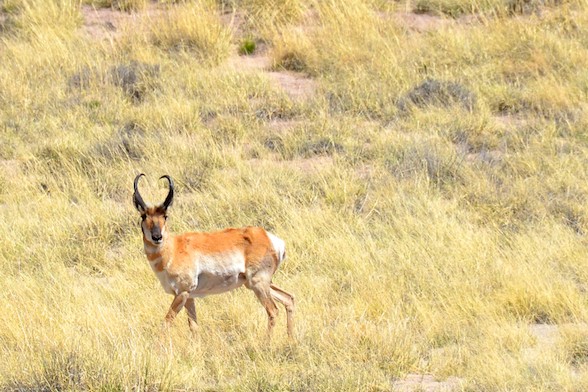Travel Photo: Pronghorn Antelope
We photographed this beautiful pronghorn antelope yesterday in the Petrified Forest National Park.
“Pronghorn antelope are only found in North America. They are often referred to as “antelope,” however, they are not closely related to any African antelope species. The scientific name originates from Antilo=antelope and capra=goat, thus antelope-goat. There are five subspecies of pronghorn, three of which occur in Arizona. They are the American pronghorn (A. a. americana), Sonoran pronghorn (A. a. sonoriensis), and Chihuahuan pronghorn (A. a. mexicana).
The name “pronghorn” is derived from a forward projection or prong on each horn. Pronghorn have true horns, in that the horn sheath is composed of fused hairs which cover a bone core. The horn sheath is shed each year in October-November. In comparison, deer and elk have antlers which are composed entirely of bone and shed completely each year. Both sexes of pronghorn have horns, but those of the female are much smaller (4 inches), seldom exceeding the length of the ear. Horns on males reach their maximum length, 12-20 inches, by the beginning of breeding season, July or August.
Pronghorn are not large animals when compared to deer or elk. Mature males, called bucks, stand 36-40 inches at the shoulder and weigh 85-130 pounds. Females, or does, weigh 75-105 pounds. Pronghorn have chunky bodies with long, slim legs. Relative to body size, they have a large windpipe, heart, and lungs which allows them to take in large amounts of air when running. These features combined with an extremely light bone structure, contribute to the pronghorn’s amazing speed. Pronghorn can maintain speeds of 40 mph for several miles, reaching 60 mph in shorter bursts.
Pronghorn are striking in appearance, with a tan body and sharply contrasting white markings on the head and neck. The belly and lower sides are creamy white and the short tail is surrounded by a large white rump patch. Unlike does, a buck’s nose is dark, brownish-black and he has a triangular black patch on each cheek. Pronghorn eyes are unusually large, about 2 inches in diameter, and are set well out on the sides of the head. This allows a wide field of vision. Biologists believe pronghorn vision is roughly equal to looking through eight-power binoculars. Whether or not this is true, they usually see you before you see them.
Pronghorn hair is very brittle and is shed throughout the year. During extreme weather conditions, the hollow hair provides excellent insulation. Pronghorn hair is also used as an alarm signal. By erecting the white rump hair, a pronghorn alerts the herd of possible danger.” (via Arizona Antelope Foundation)
We were able to enjoy the presence of this pronghorn for about 10 minutes, and we savored each moment. What a beautiful animal.
 The Roaming Boomers
The Roaming Boomers





